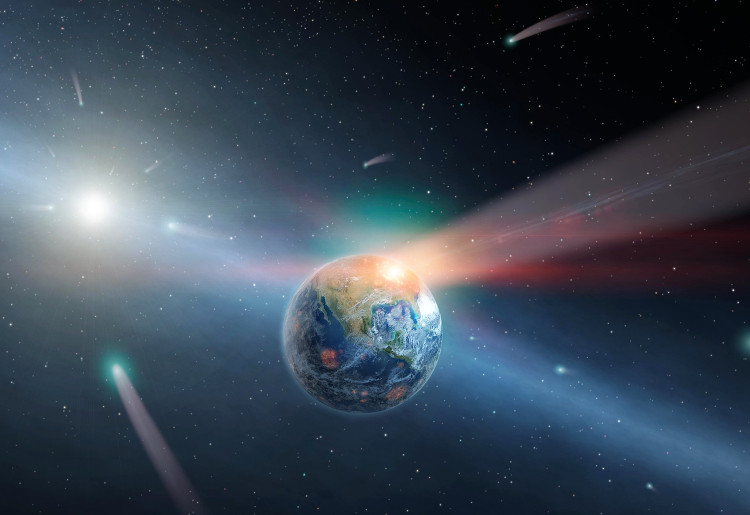Science has confused about the origin of water on Earth?
Sedimentary and ancient lava rocks indicate that water has existed for a long time on the Earth's surface. But the dry rocks in the galaxy plus the development of the oceans on Earth, ask the question: Where does water come from? Geologists say that asteroids and comets colliding with Earth have left water here.
However, recent studies have suggested another hypothesis. Accordingly , from the beginning the water was present in the rock layers of the Earth's crust and through the volcanoes it gradually exposed to the surface.
Understanding the accuracy of these two hypotheses is very important. Because it helps us understand the history of the Earth and also helps in finding other living planets.
In 1974, scientists discovered that Earth's crust contained many precious metals such as platinum. These metals are naturally attracted to iron, so at the beginning of history, most of them were sucked into the planet's iron core.
This led to the idea that asteroids hit Earth immediately after being formed and provided additional layers of material. Material not only covers precious metals but also volatile substances such as carbon and water. These substances are thought to exist on an asteroid called chondrite carbonate.

Is water really derived from asteroids?(Photo: NASA).
However, scientists believe that this hypothesis is unlikely. In January 2017, scientists found that ruthenium in the Earth's crust (one of the metals attracted by iron) had an atomic symbol different from the common asteroids in the solar system.
Thus, the materials are thought to come from within the solar system - where rare volatile substances are. And asteroids are not the main source of water on Earth. This reinforces the theory that water existed on Earth before asteroids collided.
For example, there is much evidence that the oldest mineral on the ground (zircon) crystallizes from the source of magma rock, with reaction to water. These minerals are between 4.1 and 4.3 billion years old, but materials believed to be from asteroids are only about 3.9 billion years old.
Moreover, finding water in asteroids does not mean that they can " transport" water successfully to Earth. The truth is that under the effects of asteroids, the mass of the Earth has been reduced, not increased. One of these processes is called impact or erosion impact.
A recent study of the effects of the Sudbury crater in Canada said that the collision had evaporated most of the volatile metals. Thus, volatile substances such as water - under the influence will also be dissipated in space.
Another proof that the oceans were formed early on is that there is a lot of chlorine gas on Earth. The presence of water on the planet at the beginning will dissolve chlorine and prevent them from disappearing. Unlike planetary scientists, geochemists have long argued that the ocean on Earth is not made of frozen comets, because they contain "heavy" hydrogen .
From the above conclusions, water on the surface of the Earth actually accumulates by reducing air from inside the planet. Water is kept in the Earth's crust in the form of hydroxyl groups (one hydrogen and one oxygen atom) and is trapped in minerals.

The water on the Earth's surface is actually accumulated by removing the gas from the inside of the planet.
When the shells dissolve, water dissolves into magmatic rocks. When magma emerges on the surface and cools, the pressure drops, crystals and water are released through volcanoes. With this mechanism, water from the depths can be degassed when on the surface.
The first experiments showed that minerals at a depth of 150 to 200 km could contain water. But through modeling and seismic data, scientists say water can also be found at depths between 400 and 660km below the surface.
Data on the study of diamond crystals formed underground also show that water can even be stored deeper. But water can also be "recycled" in the shell. This means that there is a balance between the water in the ocean and the water stored in the shell. We can only speculate on how much water remains in the deep layers of Earth.
The average level of sea surface is still constant for nearly four billion years. This demonstrates that the water cycle appears and is absorbed back in the crust that helps life continue to proliferate on this planet.
- Determining the origin of water on Earth
- Water on Mars and Earth can be of the same origin
- Water on the Moon and Earth has the same origin
- Water on the moon may originate from Earth
- Mars water can decipher the origin of Earth's life
- The incredible source of water on Earth
- The Black Sea changes an unusually blue color, which makes people confused
- How to decipher the Earth through Pluto?
- Summary of the best news on November 3
- Life in the earth comes from Mars
- Detected 3 billion years old water
- Could Darwin be wrong about the origin of life on Earth?
 Van Allen's belt and evidence that the Apollo 11 mission to the Moon was myth
Van Allen's belt and evidence that the Apollo 11 mission to the Moon was myth The levels of civilization in the universe (Kardashev scale)
The levels of civilization in the universe (Kardashev scale) Today Mars, the sun and the Earth are aligned
Today Mars, the sun and the Earth are aligned The Amazon owner announced a secret plan to build a space base for thousands of people
The Amazon owner announced a secret plan to build a space base for thousands of people